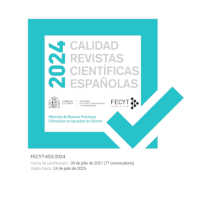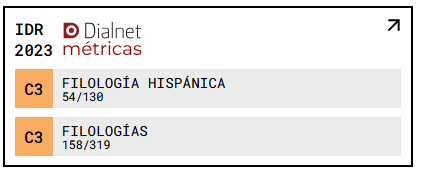The narrator in the translation of children’s literature: literary adaptations of "Don Quixote" into English
DOI:
https://doi.org/10.18172/cif.2664Keywords:
Adaptation, children’s literature, narrator, Don Quixote, intention, readerAbstract
The analysis of literary translations and adaptations of a canonical work for children or young adults shows great divergences from the source text. Narrative strategy, for example, can be modified taking into account the implicit target text reader, possible didactic purposes and the target text literary genre, among other factors. This work aims to study the reasons for adaptors to have modified the narrator in several literary adaptations of "Don Quixote" (1605). The adaptor’s visibility is clearly shown in the role of the narrator, who even becomes a character of the tale so as to engage the implicit target reader. Narrative strategy serves as a means of introducing the children or young adults to this classic book.Downloads
References
BRUNETTE, L. (2000). “A Comparison of TQA Practices”. The Translator 6 (2): 169-182. DOI: https://doi.org/10.1080/13556509.2000.10799064
BURGAN, M. (1996). Wishbone Classics. Don Quixote. New York: Harper Papers.
CADDEN. M. (Ed) (2010). “Introduction” en Telling Children’s Stories: Narrative Theory and Children’s Literature. Lincoln & London: University of Nebraska Press, pp. vii-xxv.
CHATMAN, S. (1978). Story and Discourse. Narrative Structure in Fiction and Film. London: Ithaca.
DAVIS, R. (2011). Don Quixote. New York: Self-made Hero.
EISNER, W. (2000). The Last Knight. An Introduction to Don Quixote. New York: NBM.
EZPELETA AGUILAR, F. (2011). “La formación del lector como tema en la última narrativa infantil y juvenil”. Ocnos (7): 101-110. DOI: https://doi.org/10.18239/ocnos_2011.07.08
FLORES, R. M. (1982). Sancho Panza through Three Hundred Seventy-five Years of Continuations, Imitations and Criticism 1605-1980. Newark, Delaware: Juan de la Cuesta.
GARCÍA, S. (2010). La novela gráfica. Bilbao: Astiberri.
GHESQUIERE, R. (2006). “Why does Children’s Literature Need Translations?” en Childrens Literature in Translation. (Eds. J. Coillie, y W. P. Verschueren). Manchester: St. Jerome Publishing, pp. 19-33.
HATIM, B. y MASON, I. (1997). The Translator as Communicator. London: Routledge.
HUNT, P. (2001). Children’s Literature. Oxford: Wiley-Blackwell.
KIMMEL, E. (2004). Don Quixote and the Windmills. New York: Farrar, Straus and Giroux.
LATHEY, G. (2010). The Role of Translators in Children’s Literature: Invisible Storyteller. London: Routledge. DOI: https://doi.org/10.4324/9780203845233
LEFEBVRE, B. (2012). Textual Transformations in Children’s Literature. Adaptations, Transformations, Reconsiderations. London: Routledge.
LORENZO GARCÍA, L. (2008). “Estudio del doblaje al español peninsular de Pocahontas (Disney)” en Diálogos intertextuales 1: Pocahontas. (Ed. V. Ruzicka). Frankfurt and Main: Peter Lang, pp. 89-106.
MONTERO REGUERA, J. (1997). El Quijote y la crítica contemporánea. Madrid: Centro de Estudios Cervantinos.
NIKOLAJEVA, M. (2005). Aesthetic Approaches to Children’s Literature: An Introduction. New York: Scarecrow Press.
OITTINEN, R. (2006). “No innocent Act: On the Ethics of Translating for Children” en Childrens Literature in Translation. (Eds. J. Coillie, y W. P. Verschueren). Manchester: St. Jerome Publishing, pp. 35-46.
O’SULLIVAN, E. (2003). “Narratology meets Translation Studies, or, the voice of the Translator in Children’s Literature”. Meta 48 (1-2): 197-207. DOI: https://doi.org/10.7202/006967ar
PASCUA FEBLES, I. (1998). La adaptación en la traducción de la literatura infantil. Las Palmas de Gran Canaria: Universidad de las Palmas de Gran Canaria.
REIT, S. (2007). Great Heroes. The Legends of King Arthur. Don Quixote. The Adventures of Sherlock Holmes. Il. Ernie Colón. New York: Gareth Stevens.
RUSS, K. (Ed.) (2012). The Graphic Canon. The World’s Greatest Literature as Comic and Visuals. V.1. New York: Seven Stories Press.
SALMERÓN VÍLCHEZ, P. (2004). Transmisión de valores a través de los cuentos infantiles clásicos. Granada: Editorial de la Universidad de Granada. Tesis doctoral.
SCHWENKE, W. A. (2003). “The Value of Singularity in First- and Restricted Third-Person Engaging Narration”. Children’s Literature 31: 116-141. DOI: https://doi.org/10.1353/chl.2003.0017
SHAVIT, Z. (2006). “Translation of Children’s Literature” en The Translation of Children’s Literature: A Reader. (Ed. G. Lathey). Clevedon: Multilingual Matters, pp. 25-40.
SOTOMAYOR SÁEZ, V. (2005). “Literatura, sociedad, educación: las adaptaciones literarias”. Revista de educación, número extraordinario: 217-238.
TABERNERO SALA, R. (2005). Nuevas y viejas formas de contar. El discurso narrativo infantil en los umbrales del siglo XXI. Zaragoza: Prensas Universitarias de Zaragoza. DOI: https://doi.org/10.26754/uz.84-7733-795-0
TOLEDANO BUENDÍA, C. (2001-2002). “Traducción y adecuación de la literatura para adultos a un público infantil y juvenil”. Cuadernos de investigación filológica 27-28: 103-120. DOI: https://doi.org/10.18172/cif.2202
VENUTI, L. (1995). The Translator’s Invisibility. A History of Translation. London, New York: Routledge.
WALL, B. (1991). The Narrator’s Voice: The Dilemma of Children’s Fiction. London: McMillan. DOI: https://doi.org/10.1007/978-1-349-21109-8
Downloads
Published
How to Cite
Issue
Section
License
The authors retain copyright of articles and authorize CIF the first publication. They are free to share and redistribute the article without obtaining permission from the publisher as long as they give appropriate credit to the editor and the journal.
Self-archiving is allowed too. In fact, it is recommendable to deposit a PDF version of the paper in academic and/or institutional repositories.
It is recommended to include the DOI number.
This journal is licensed under a Creative Commons Attribution 4.0 International License














